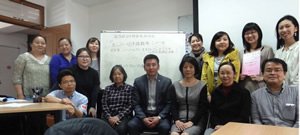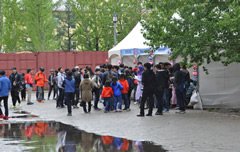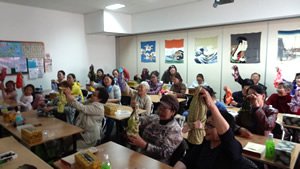Mongolia-Japan Center for Human Resources Development - Aiming for Reciprocal Cultural Exchanges Between Mongolia and Japan
Mongolia-Japan Center for Human Resources Development
SAITO Satoko
10th Japanese-Language Education Symposium to be Held
A common challenge faced by Japanese-language learners in Mongolia, including the Mongolia Japanese-Language Teachers Association (hereinafter the “Teachers Association”), has been that the reading comprehension of Japanese-language learners in the country is inferior to their other language abilities. In fact, the results of a study in the Japanese-Language Proficiency Test (hereinafter “JLPT”) confirm that Japanese-language learners in Mongolia score lower on reading comprehension than on other areas. Partly in light of that, at the Teachers Association’s first meeting of fiscal 2016, it was decided to set “improving reading comprehension” as a theme and to work on improving reading comprehension across the course of the year.
Specifically, in order to compare reading comprehension education in Mongolia’s mother tongue education with reading comprehension education in Japan’s Japanese-language education, a study was carried out from various perspectives, including comparing the reading comprehension directives in the textbooks and comparing the varieties of reading comprehension teaching materials.
Subsequently, a Japanese-language education symposium was held over a two-day period on March 17–18, 2017 in order to announce the outcomes of the one year of research. The theme of this symposium was “What is reading comprehension? Cultivating reading ability.” It was hosted by The Japan Foundation (hereinafter the “JF”). 2017 marked the 15th anniversary of the founding of the Mongolia-Japan Center for Human Resources Development (hereinafter the “Japan Center”), and it also marked the 45th anniversary of the establishment of diplomatic relations between Japan and Mongolia. Consequently, this symposium was also recognized as a commemorative event for these 15- and 45-year anniversaries.
Two keynote speakers were invited from Japan. A keynote speaker from Mongolia’s Ministry of Education and Science also participated and gave a presentation on education in Mongolia. Following that, members of the Teachers Association split into nine section meetings to unveil the results of the one-year period of research and study, and received beneficial advice from the invited speakers. This meeting was a great success, attracting the participation of around 200 people in total. Participants centered on Japanese-language teachers, and included teachers from not only the capital city of Ulaanbaatar but also from schools located several hundred kilometers away.
This symposium helped shed light on the path to be taken with initiatives for “improving reading comprehension,” but it also served as an opportunity to learn from the invited speakers that being aware of one’s challenges and researching and studying them is both enjoyable and beneficial.
Overview of the Mongolia Japanese-Language Teachers Association for the Current Year, and Japanese-Language Specialists’ Views on the Challenges Going Forward
On May 13, 2017, Teacher Association Chairman Batjargal presented an overview of the Teacher Association’s 2016 year (September 2016 to June 2017).

The 75th meeting overview of the current year
Teachers Association members
In that presentation, Batjargal explained that “The number of attendants at the ‘Competitive School Speech Contest’ (co-hosted by the Embassy of Japan in Mongolia, the Japan Center and JF) increased from 170 in the 2015 year to 240 in the 2016 year; the number of people sitting the JLPT increased from 1,285 in the 2015 year to 1,667 in the 2016 year; and the number of applicants for the Examination for Japanese University Admission for International Students (EJU) doubled to 350, from 158 in the 2015 year. These figures show that there is interest in Japanese-language education in Mongolia, and that demand for Japanese-language learning is increasing.”
Additionally, it was reported that an event called the “Kanji Naadam” (Naadam means festival in Mongolian), which was aimed at familiarizing participants with kanji in a lighthearted way, was held twice, and that JF Nihongo Network (Sakura Network) educational trip to Japan had taken place.
In addition, in the current year the first through to the third (final volume) volumes of “Nihongo Dekirumon” for learners were completed. The overview noted that the final volume was published under the “Mongolian Primary to Lower Secondary School JF Standard for Japanese-Language Education Textbook Publication and Printing Project” with the assistance of JF, and that this was a major outcome of this regular meeting of the Society.
As Japanese-Language Specialists (hereinafter “Specialists”), we view the challenges relating to the Teachers Association going forward as reviewing the burden for running events such as the ones cited above, including this regular meeting of the Society, and for the Teachers Association to take the lead in implementing steps to ensure that the duties are not unduly shouldered by the Mongolia-Japan Center for Human Resources Development or by specific Japanese-language section staff, Specialists and adjustment members for JF courses at the Mongolia-Japan Center for Human Resources Development. To that end, it will no doubt be essential for the Teachers Association to be run independently, and for the Mongolian Education Bureau and Mongolian National University of Education, which offers Japanese-language education majors, to actively participate as well. Specialists and adjustment members for JF course want to support self-reliance as observers, rather than being in a position of taking the initiative and managing events as they are now.
“Japan Festival” A Roaring Success!!!

People milling around the booths
Following Mongolia’s long, harsh winter, it has turned to spring, when the weather is changeable.
This year’s “Japan Festival” was recognized as a celebratory event for the 45th anniversary of the establishment of diplomatic relations between Japan and Mongolia. It also celebrated the Japan Center’s 15th anniversary. Various events and culture experience workshops were held thanks to an all-out mobilization of the Japan Center’s staff. The traditional Japanese cultures on offer were Sado (tea ceremony), Shodo (calligraphy), Furoshiki (cloth wrapping), dressing up in Yukata (summer cotton kimono) for photographs, Japanese games, and Kendama (Japanese bilboquet). Aside from the Furoshiki and the Japanese games, Mongolian staff and Mongolian volunteers were in charge of all of these.

The furoshiki workshop
Specialists were in charge of a workshop teaching the history of furoshiki and five wrapping styles. The subcultures covered were Anime, Manga, cosplay, quiz contests and Karaoke contests, and the Anime and Manga events were run by members of a group that arose out of the “Marugoto: Japanese Language and Culture Course.”
The Japan Center’s library and information section and Japanese-language section drew on their experience running regular culture experience workshops and did an outstanding job. The weather was poor on the day, with light rain from the morning and temperatures of below 10 degrees, but contrary to our expectations 1,850 people attended. Considering that the event attracted 1,500 people when it was held three years ago, it appears that the number of people interested in Japan’s traditional cultures and subcultures is growing.
Going forward also, we intend to promote reciprocal cultural understanding between Japan and Mongolia.
- What We Do Top
- Arts and Cultural Exchange [Culture]
- Japanese-Language Education Overseas [Language]
- Japanese-Language Education Overseas [Language] Top
- Learn Japanese-language
- Teach Japanese-language
- Take Japanese-Language Test
- Know about Japanese-language education abroad
- The Japanese-Language Institute, Urawa
- The Japanese-Language Institute, Kansai
- Japanese-Language Programs for Foreign Specified Skilled Worker Candidates
- Japanese Language Education for Japanese Children Resident Overseas and for the Descendants of Migrants
- Archives
- Japanese Studies and Global Partnerships [Dialogue]
- JF digital collection
- Other Programs / Programs to Commemorate Exchange Year
- Awards and Prizes
- Publications
